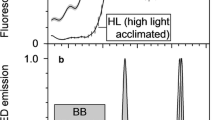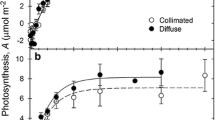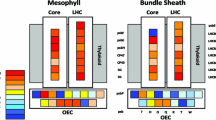Abstract
The existence of major vertical gradients within the leaf is often overlooked in studies of photosynthesis. These gradients, which involve light heterogeneity, cell composition, and CO2 concentration across the mesophyll, can generate differences in the maximum potential PSII efficiency (F V/F M or F V/F P) of the different cell layers. Evidence is presented for a step gradient of F V/F P ratios across the mesophyll, from the adaxial (palisade parenchyma, optimal efficiencies) to the abaxial (spongy parenchyma, sub-optimal efficiencies) side of Quercus coccifera leaves. For this purpose, light sources with different wavelengths that penetrate more or less deep within the leaf were employed, and measurements from the adaxial and abaxial sides were performed. To our knowledge, this is the first report where a low photosynthetic performance in the abaxial side of leaves is accompanied by impaired F V/F P ratios. This low photosynthetic efficiency of the abaxial side could be related to the occurrence of bundle sheath extensions, which facilitates the penetration of high light intensities deep within the mesophyll. Also, leaf morphology (twisted in shape) and orientation (with a marked angle from the horizontal plane) imply direct sunlight illumination of the abaxial side. The existence of cell layers within leaves with different photosynthetic efficiencies makes appropriate the evaluation of how light penetrates within the mesophyll when using Chl fluorescence or gas exchange techniques that use different wavelengths for excitation and/or for driving photosynthesis.





Similar content being viewed by others
Abbreviations
- A :
-
Net CO2 uptake
- BSE:
-
Bundle sheath extensions
- Chl:
-
Chlorophyll
- ETR :
-
Electron transport rate
- ΦPSII and Φexc. :
-
Actual and intrinsic photosystem II efficiencies, respectively
- FO and \(F^{\prime}_{O}\):
-
Minimal Chl fluorescence yield in the dark or during light adaptation, respectively
- FM and \(F^{\prime}_{M}\):
-
Maximal Chl fluorescence yield in the dark or during light adaptation, respectively
- F S :
-
Chl fluorescence at steady-state photosynthesis
- F P :
-
Chl fluorescence at the peak of the continuous fluorescence induction curve
- FV and \(F^{\prime}_{V}\):
-
FM − FO or FP − FO, and \(F^{\prime}_{M}\) − \(F^{\prime}_{O}\), respectively
- g S :
-
Stomatal conductance
- NPQ :
-
Non-photochemical quenching
- PPFD:
-
Photosynthetic photon flux density
- PSI and PSII:
-
Photosystems I and II, respectively
- qP :
-
Photochemical quenching
References
Abadía A, Gil E, Morales F, Montañés L, Montserrat G, Abadía J (1996) Marcescence and senescence in a submediterranean oak (Quercus subpyrenaica E.H. del Villar): photosynthetic characteristics and nutrient composition. Plant Cell Environ 19:685–694. doi:10.1111/j.1365-3040.1996.tb00403.x
Abadía J, Morales F, Abadía A (1999) Photosystem II efficiency in low chlorophyll, iron-deficient leaves. Plant Soil 215:183–192. doi:10.1023/A:1004451728237
Agati G, Cerovic ZG, Moya I (2000) The effect of decreasing temperature up to chilling values on the in vivo F685/F735 chlorophyll fluorescence ratio in Phaseolus vulgaris and Pisum sativum: the role of photosystem I contribution to the 735 nm fluorescence band. Photochem Photobiol 72(1):75–84. doi:10.1562/0031-8655(2000)072<0075:TEODTU>2.0.CO;2
Balaguer L, Martínez-Ferri E, Valladares F, Pérez-Corona ME, Baquedano FJ, Castillo FJ, Manrique E (2001) Population divergence in the plasticity of the response of Quercus coccifera to the light environment. Funct Ecol 15:124–135. doi:10.1046/j.1365-2435.2001.00505.x
Belkhodja R, Morales F, Quílez R, López-Millán AF, Abadía A, Abadía J (1998) Iron deficiency causes changes in chlorophyll fluorescence due to reduction in the dark of the photosystem II acceptor side. Photosynth Res 56:265–276. doi:10.1023/A:1006039917599
Bilger W, Björkman O (1990) Role of the xanthophyll cycle in photoprotection elucidated by measurements of light-induced absorbance changes, fluorescence and photosynthesis in leaves of Hedera canariensis. Photosynth Res 25:173–185. doi:10.1007/BF00033159
Bilger W, Veit M, Schreiber L, Schreiber U (1997) Measurement of leaf epidermal transmittance of UV radiation by chlorophyll fluorescence. Physiol Plant 101:754–763. doi:10.1111/j.1399-3054.1997.tb01060.x
Björkman O, Demmig B (1987) Photon yield of O2 evolution and chlorophyll fluorescence characteristics at 77 K among vascular plants of diverse origins. Planta 170:489–504. doi:10.1007/BF00402983
Bolhar-Nordenkampf HR, Long PS, Baker NR, Oquist G, Schreiber U, Lechner EG (1989) Chlorophyll fluorescence as a probe of the photosynthetic competence of leaves in the field: a review of current instrumentation. Funct Ecol 3:497–514. doi:10.2307/2389624
Bornman JF, Vogelmann TC, Martin G (1991) Measurement of chlorophyll fluorescence within leaves using a fiber optic microprobe. Plant Cell Environ 14:719–725. doi:10.1111/j.1365-3040.1991.tb01546.x
Briantais JM, Vernotte C, Krause GH, Weis E (1986) Chlorophyll a fluorescence of higher plants: chloroplasts and leaves. In: Govindjee, Amesz J, Fork DC (eds) Light emission by plants and bacteria. Academic Press, Orlando, pp 539–583
Buschmann C (2007) Variability and application of the chlorophyll fluorescence emission ratio red/far-red of leaves. Photosynth Res 92:261–271. doi:10.1007/s11120-007-9187-8
Cerovic ZG, Samson G, Morales F, Tremblay N, Moya I (1999) Ultraviolet-induced fluorescence for plant monitoring: present state and prospects. Agronomie 19:543–578. doi:10.1051/agro:19990701
Cerovic ZG, Ounis A, Cartelat A, Latouche G, Goulas Y, Meyer S, Moya I (2002) The use of chlorophyll fluorescence excitation spectra for the non-destructive in situ assessment of UV-absorbing compounds in leaves. Plant Cell Environ 25:1663–1676. doi:10.1046/j.1365-3040.2002.00942.x
Cui M, Vogelmann TC, Smith WK (1991) Chlorophyll and light gradients in sun and shade leaves of Spinacia oleracea. Plant Cell Environ 14:493–500. doi:10.1111/j.1365-3040.1991.tb01519.x
Dau H (1994) Molecular mechanisms and quantitative models of variable photosystem II fluorescence. Photochem Photobiol 60:1–23
Evans JR (1999) Leaf anatomy enables more equal access to light and CO2 between chloroplasts. New Phytol 143:93–104. doi:10.1046/j.1469-8137.1999.00440.x
Evans JR, Vogelmann TC (2006) Photosynthesis within isobilateral Eucalyptus pauciflora leaves. New Phytol 171:771–782. doi:10.1111/j.1469-8137.2006.01789.x
Evans JR, von Caemmerer S (1996) Carbon dioxide diffusion inside leaves. Plant Physiol 110:339–346
Evans JR, Jakobsen I, Ögren E (1993) Photosynthetic light response curves. 2. Gradients of light absorption and photosynthetic capacity. Planta 189:191–200. doi:10.1007/BF00195076
Flexas J, Medrano H (2002) Energy dissipation in C3 plants under drought. Funct Plant Biol 29:1209–1215. doi:10.1071/FP02015
Flexas J, Escalona JM, Medrano H (1999) Water stress induces different levels of photosynthesis and electron transport rate regulation in grapevines. Plant Cell Environ 22:39–48. doi:10.1046/j.1365-3040.1999.00371.x
Fukshansky L (1981) Optical properties of plants. In: Smith H (ed) Plants and the daylight spectrum. Academic Press, London, pp 21–40
Genty B, Briantais JM, Baker NR (1989) The relationship between the quantum yield of photosynthetic electron transport and quenching of chlorophyll fluorescence. Biochim Biophys Acta 990:87–92
Govindjee (1995) Sixty-three years since Kautsky: chlorophyll a fluorescence. Aust J Plant Physiol 22:131–160
Harbinson J, Genty B, Baker NR (1989) Relationship between the quantum efficiencies of photosystems I and II in pea leaves. Plant Physiol 90:1029–1034
Joshi MK, Mohanty P (1995) Probing photosynthetic performance by chlorophyll a fluorescence: analysis and interpretation of fluorescence parameters. J Sci Ind Res (India) 54:155–174
Karabourniotis G, Bornman JF, Nikolopoulos D (2000) A possible optical role of the bundle sheath extensions of the heterobaric leaves of Vitis vinifera and Quercus coccifera. Plant Cell Environ 23:423–430. doi:10.1046/j.1365-3040.2000.00558.x
Kolb CA, Schreiber U, Gademann R, Pfündel EE (2005) UV-A screening in plants determined using a new portable fluorometer. Photosynthetica 43(3):371–377. doi:10.1007/s11099-005-0061-7
Krall JP, Edwards GE (1992) Relationship between photosystem II activity and CO2 fixation in leaves. Physiol Plant 86:180–187. doi:10.1111/j.1399-3054.1992.tb01328.x
Krause GH, Weis E (1991) Chlorophyll fluorescence and photosynthesis: the basics. Annu Rev Plant Physiol Plant Mol Biol 42:313–349. doi:10.1146/annurev.pp.42.060191.001525
Li PM, Fang P, Wang WB, Gao HY, Peng T (2007) The higher resistance to chilling stress in adaxial side of Rumex K-1 leaves is accompanied with higher photochemical and non-photochemical quenching. Photosynthetica 45(4):496–502. doi:10.1007/s11099-007-0086-1
Lichtenthaler HK, Rinderle U (1988) The role of chlorophyll fluorescence in the detection of stress conditions in plants. CRC Crit Rev Anal Chem 19:S29–S85
Louis J, Cerovic ZG, Moya I (2006) Quantitative study of fluorescence excitation and emission spectra of bean leaves. J Photochem Photobiol B Biol 85:65–71. doi:10.1016/j.jphotobiol.2006.03.009
Markstädter C, Queck I, Baumeister J, Riederer M, Schreiber U, Bilger W (2001) Epidermal transmittance of leaves of Vicia faba for UV radiation as determined by two different methods. Photosynth Res 67:17–25. doi:10.1023/A:1010676111026
Medrano H, Bota J, Abadía A, Sampól B, Escalona JM, Flexas J (2002) Effects of drought on light-energy dissipation mechanisms in high-light-acclimated, field-grown grapevines. Funct Plant Biol 29:1197–1207. doi:10.1071/FP02016
Morales F, Abadía A, Abadía J (1990) Characterization of the xanthophyll cycle and other photosynthetic pigment changes induced by iron deficiency in sugar beet (Beta vulgaris L.). Plant Physiol 94:607–613
Morales F, Abadía A, Abadía J (1991) Chlorophyll fluorescence and photon yield of oxygen evolution in iron-deficient sugar beet (Beta vulgaris L.) leaves. Plant Physiol 97:886–893
Morales F, Abadía A, Abadía J (1998) Photosynthesis, quenching of chlorophyll fluorescence and thermal energy dissipation in iron-deficient sugar beet leaves. Aust J Plant Physiol 25:403–412
Morales F, Moise N, Quílez R, Abadía A, Abadía J, Moya I (2001) Iron deficiency interrupts energy transfer from a disconnected part of the antenna to the rest of photosystem II. Photosynth Res 70:207–220. doi:10.1023/A:1017965229788
Morales F, Abadía A, Abadía J, Montserrat G, Gil-Pelegrín E (2002) Trichomes and photosynthetic pigment composition changes: responses of Quercus ilex subsp. ballota (Desf.) Samp and Quercus coccifera L. to Mediterranean stress conditions. Trees (Berl) 16:504–510. doi:10.1007/s00468-002-0195-1
Morales F, Abadía A, Abadía J (2006) Photoinhibition and photoprotection under nutrient deficiencies, drought and salinity. In: Demmig-Adams B, Adams WWIII, Mattoo AK (eds) Photoprotection, photoinhibition, gene regulation, and environment. Springer, Dordrecht, pp 65–85
Nishio JN (2000) Why are higher plants green? Evolution of the higher plant photosynthetic pigment complement. Plant Cell Environ 23:539–548. doi:10.1046/j.1365-3040.2000.00563.x
Nishio JN, Sun J, Vogelmann TC (1993) Carbon fixation gradients across spinach leaves do not follow internal light gradients. Plant Cell 5:953–961
Osborne BA, Raven JA (1986) Light absorption by plants and its implications for photosynthesis. Biol Rev Camb Philos Soc 61:1–61. doi:10.1111/j.1469-185X.1986.tb00425.x
Outlaw WH Jr (1987) A minireview: comparative biochemistry of photosynthesis in palisades cells, spongy cells, and guard cells of C3 leaves. Prog Photosynth Res 4:265–272
Papageorgiou G (1975) Chlorophyll fluorescence: an intrinsic probe of photosynthesis. In: Govindjee (ed) Bioenergetics of photosynthesis. Academic Press, New York, pp 319–371
Parkhurst DF (1986) Internal leaf structure: a three dimensional perspective. In: Givnish TJ (ed) On the economy of plant form and function. Cambridge University Press, Cambridge, pp 215–249
Peguero-Pina JJ (2008) Empleo de técnicas no destructivas en la sintomatología de la respuesta de la vegetación arbórea de interés forestal a distintos factores abióticos de estrés. PhD Thesis, University of Lérida, Spain
Peguero-Pina JJ, Morales F, Flexas J, Gil-Pelegrín E, Moya I (2008) Photochemistry, remotely sensed physiological reflectance index and de-epoxidation state of the xanthophyll cycle in Quercus coccifera under intense drought. Oecologia 156:1–11. doi:10.1007/s00442-007-0957-y
Peterson RB, Oja V, Laisk A (2001) Chlorophyll fluorescence at 680 and 730 nm and leaf photosynthesis. Photosynth Res 70:185–196. doi:10.1023/A:1017952500015
Quílez R, Abadía A, Abadía J (1992) Characteristics of thylakoids and photosystem II membrane preparations from iron deficient and iron sufficient sugar beet (Beta vulgaris L.). J Plant Nutr 15:1809–1819
Renger G, Schreiber U (1986) Practical applications of fluorometric methods to algae and higher plant research. In: Govindjee, Amesz J, Fork DC (eds) Light emission by plants and bacteria. Academic Press, Orlando, pp 587–619
Schreiber U, Bilger W (1993) Progress in chlorophyll fluorescence research: major developments during the past years in retrospect. In: Progress in botany. Springer Verlag, Berlin, Heildelberg, pp 151–173
Schreiber U, Neubauer C, Schliwa U (1993) PAM fluorometer based on medium-frequency pulsed Xe-flash measuring light: a highly sensitive new tool in basic and applied photosynthesis research. Photosynth Res 36:65–72. doi:10.1007/BF00018076
Schreiber U, Bilger W, Neubauer C (1994) Chlorophyll fluorescence as a noninvasive indicator for rapid assessment of in vivo photosynthesis. In: Schulze ED, Caldwell MM (eds) Ecophysiology of photosynthesis. Springer-Verlag, Berlin, pp 49–70
Schreiber U, Kühl M, Klimant I, Reising H (1996) Measurement of chlorophyll fluorescence within leaves using a modified PAM fluorometer with a fiber-optic microprobe. Photosynth Res 47:103–109. doi:10.1007/BF00017758
Seyfried M, Fukshansky L (1983) Light gradients in plant tissue. Appl Opt 22:1402–1408
Sun J, Nishio JN, Vogelmann TC (1996) High-light effects on CO2 fixation gradients across leaves. Plant Cell Environ 19:1261–1271. doi:10.1111/j.1365-3040.1996.tb00004.x
Sun J, Nishio JN, Vogelmann TC (1998) Green light drives CO2 fixation deep within leaves. Plant Cell Physiol 39:1020–1026
Terashima I (1989) Productive structure of a leaf. In: Briggs WR (ed) Photosynthesis: proceedings of the C.S. French symposium, Alan R Liss, Inc, New York, pp 207–226
Terashima I, Inoue Y (1985a) Palisade tissue chloroplasts and spongy tissue chloroplasts in spinach: biochemical and ultrastructural differences. Plant Cell Physiol 26:63–75
Terashima I, Inoue Y (1985b) Vertical gradient in photosynthetic properties of spinach chloroplasts dependent on intra-leaf light environment. Plant Cell Physiol 26:781–785
Terashima I, Saeki T (1983) Light environment within a leaf. I. Optical properties and paradermal sections of Camelia leaves with special reference to differences in the optical properties of palisade and spongy tissues. Plant Cell Physiol 24:1493–1501
Terashima I, Sakaguchi S, Hara N (1986) Intra-leaf and intracellular gradients in chloroplast ultrastructure of dorsiventral leaves illuminated from the adaxial or abaxial side during their development. Plant Cell Physiol 27:1023–1031
Valentini R, Epron D, De Angelis P, Matteucci G, Dreyer E (1995) In situ estimation of net CO2 assimilation, photosynthetic electron flow and photorespiration in Turkey oak (Quercus cerris L.) leaves: diurnal cycles under different levels of water supply. Plant Cell Environ 18:631–640. doi:10.1111/j.1365-3040.1995.tb00564.x
van Kooten O, Snel JHF (1990) The use of chlorophyll fluorescence in plant stress physiology. Photosynth Res 25:147–150. doi:10.1007/BF00033156
Vogelmann TC (1986) Light within the plant. In: Kendrick RE, Kronenberg GHM (eds) Photomorphogenesis in Plants. Martinus Nijhoff, Dordrecht, pp 307–337
Vogelmann TC (1989) Penetration of light into plants. Photochem Photobiol 50(6):895–902. doi:10.1111/j.1751-1097.1989.tb02919.x
Vogelmann TC, Björn LO (1986) Plants as light traps. Physiol Plant 68:704–708. doi:10.1111/j.1399-3054.1986.tb03421.x
Vogelmann TC, Evans JR (2002) Profiles of light absorption and chlorophyll within spinach leaves from chlorophyll fluorescence. Plant Cell Environ 25:1313–1323. doi:10.1046/j.1365-3040.2002.00910.x
Vogelmann TC, Han T (2000) Measurement of gradients of absorbed light in spinach leaves from chlorophyll fluorescence profiles. Plant Cell Environ 23:1303–1311. doi:10.1046/j.1365-3040.2000.00649.x
Vogelmann TC, Martin G (1993) The functional significance of palisade tissue: penetration of directional versus diffuse light. Plant Cell Environ 16:65–72. doi:10.1111/j.1365-3040.1993.tb00845.x
Vogelmann TC, Bornman JF, Josserand S (1989) Photosynthetic light gradients and spectral regime within leaves of Medicago sativa. Philos Trans R Soc Lond B Biol Sci 323:411–421. doi:10.1098/rstb.1989.0020
von Caemmerer S, Farquhar GD (1981) Some relationships between the biochemistry of photosynthesis and the gas exchange of leaves. Planta 153:376–387. doi:10.1007/BF00384257
Acknowledgments
This work was supported by INIA project RTA01-071-C3-1 (Ministerio de Educación y Ciencia), and Gobierno de Aragón. Authors acknowledge comments of two anonymous reviewers that largely improved this manuscript.
Author information
Authors and Affiliations
Corresponding author
Rights and permissions
About this article
Cite this article
Peguero-Pina, J.J., Gil-Pelegrín, E. & Morales, F. Photosystem II efficiency of the palisade and spongy mesophyll in Quercus coccifera using adaxial/abaxial illumination and excitation light sources with wavelengths varying in penetration into the leaf tissue. Photosynth Res 99, 49–61 (2009). https://doi.org/10.1007/s11120-008-9393-z
Received:
Accepted:
Published:
Issue Date:
DOI: https://doi.org/10.1007/s11120-008-9393-z




